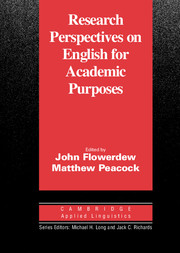Book contents
- Frontmatter
- Contents
- List of contributors
- Series editors' preface
- Preface
- I ISSUES IN ENGLISH FOR ACADEMIC PURPOSES
- Introduction to Part I
- 1 Issues in EAP: A preliminary perspective
- 2 Language use, language planning and EAP
- 3 EAP-related linguistic research: An intellectual history
- 4 Linguistic research and EAP pedagogy
- 5 International scientific English: The language of research scientists around the world
- 6 Discipline specificity and EAP
- 7 World Englishes: Issues in and from academic writing assessment
- 8 Addressing issues of power and difference in ESL academic writing
- 9 ‘I'll go with the group’: Rethinking ‘discourse community’ in EAP
- 10 EAP assessment: Issues, models, and outcomes
- II THE ENGLISH FOR ACADEMIC PURPOSES CURRICULUM
- References
- Index
6 - Discipline specificity and EAP
Published online by Cambridge University Press: 05 October 2012
- Frontmatter
- Contents
- List of contributors
- Series editors' preface
- Preface
- I ISSUES IN ENGLISH FOR ACADEMIC PURPOSES
- Introduction to Part I
- 1 Issues in EAP: A preliminary perspective
- 2 Language use, language planning and EAP
- 3 EAP-related linguistic research: An intellectual history
- 4 Linguistic research and EAP pedagogy
- 5 International scientific English: The language of research scientists around the world
- 6 Discipline specificity and EAP
- 7 World Englishes: Issues in and from academic writing assessment
- 8 Addressing issues of power and difference in ESL academic writing
- 9 ‘I'll go with the group’: Rethinking ‘discourse community’ in EAP
- 10 EAP assessment: Issues, models, and outcomes
- II THE ENGLISH FOR ACADEMIC PURPOSES CURRICULUM
- References
- Index
Summary
Introduction
It is the custom in learner-centred EAP classes for teachers to give students a choice of topics to study. Some students ask for texts from subject areas outside their chosen field of study in the hope that such topics, being novel, might be more interesting (see Carrell, 1983 on salience, and Fransson, 1984 on interest). Others, however, prefer texts relating to their academic area so that they can gain practical experience of typical texts in their field of study. (By ‘text’ here, I am referring to both written and spoken texts.) It is these latter students that we are concerned with here, since their wishes tie in not only with theories about ESP teaching (see, for example, Dudley Evans, 1994; and Waters, 1997), but also with theoretical work in the area of cognition, notably schema theory and notions of how knowledge is stored in the brain.
Before I move on to discuss different theories of comprehension, I should explain what I mean by EAP. Since EAP is concerned with the English required for the specific purpose of studying at universities and colleges, it can be seen as being subordinate to ESP (see Jordan, 1989, and Robinson, 1991). EAP courses can be divided into those for English for General Academic Purposes (EGAP) and those for English for Specific Academic Purposes (ESAP) (see Blue, 1993; Jordan, 1997; Dudley-Evans and St John, 1998).
- Type
- Chapter
- Information
- Research Perspectives on English for Academic Purposes , pp. 84 - 100Publisher: Cambridge University PressPrint publication year: 2001
- 6
- Cited by

